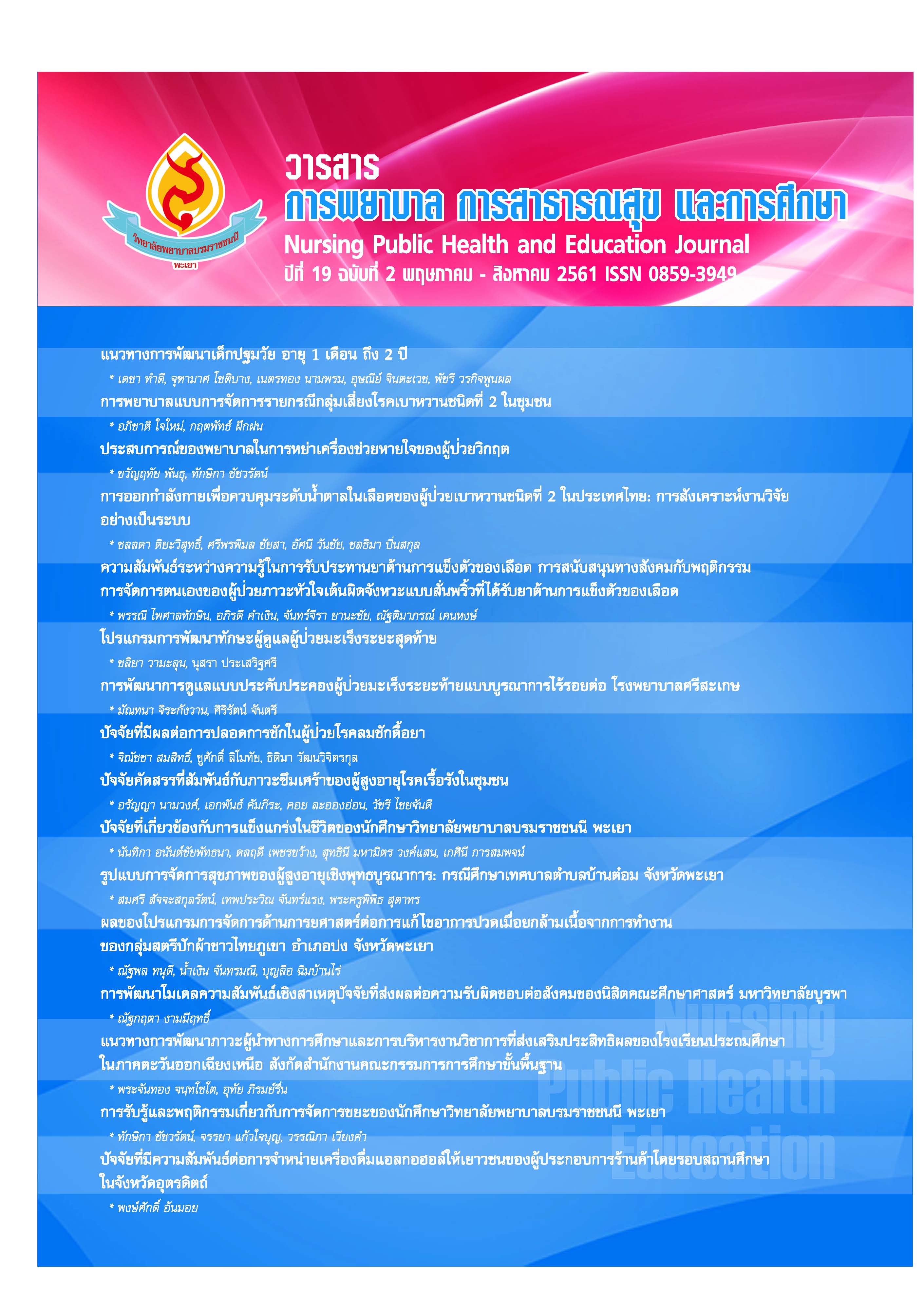การพัฒนาการดูแลแบบประคับประคองผู้ป่วยมะเร็งระยะท้ายแบบบูรณาการไร้รอยต่อ โรงพยาบาลศรีสะเกษ
Keywords:
การพัฒนารูปแบบ, ผู้ป่วยมะเร็งระยะท้าย, การดูแลแบบประคับประคอง, Palliative care, Cancer patients, End of Life, Integration of care, Seamless NetworkAbstract
ผู้ป่วยมะเร็งระยะท้ายต้องเผชิญกับความทุกข์ทรมานทั้งด้านร่างกาย จิตใจ สังคม และจิตวิญญาณบริบทให้การดูแลแบบประคับประคองของแต่ละโรงพยาบาลมีความแตกต่างกัน จึงมีความจำเป็นในการพัฒนาการดูแลแบบประคับประคองผู้ป่วยมะเร็งระยะท้ายตามบริบทของแต่ละโรงพยาบาลเพื่อให้เกิดผลลัพธ์การดูแลที่ดีการวิจัยและพัฒนาครั้งนี้มีวัตถุประสงค์เพื่อพัฒนาและศึกษาผลของการดูแลผู้ป่วยมะเร็งระยะท้ายแบบประคับประคองโรงพยาบาลศรีสะเกษโดยใช้กรอบแนวคิดการดูแลผู้ป่วยระยะสุดท้ายขององค์การอนามัยโลก ร่วมกับทฤษฎีการดูแลมนุษย์ของวัตสันกลุ่มตัวอย่างประกอบด้วยผู้ป่วยมะเร็งระยะท้าย 30 คน ผู้ดูแลหลัก 30 คน และทีมผู้ให้บริการ 199 คนประกอบด้วย พยาบาล 168 คน แพทย์ 22 คน นักกายภาพบำบัด 5 คน นักโภชนาการ 2 คน เภสัชกร 1 คน และนักสังคมสงเคราะห์ 1 คนเครื่องมือที่ใช้ ได้แก่ 1) เครื่องมือดำเนินการพัฒนาการดูแล และ 2) เครื่องมือประเมินผลลัพธ์ ที่ผ่านการตรวจสอบความตรงของเนื้อหาโดยผู้ทรงคุณวุฒิ 7 และ 5 ท่าน ตามลำดับ และผ่านการทดสอบหาความเที่ยงตรง โดยใช้สัมประสิทธิ์แอลฟาครอนบาค วิเคราะห์ข้อมูลเชิงปริมาณโดยสถิติเชิงพรรณนา ผลการศึกษาพบว่าการดูแลผู้ป่วยมะเร็งระยะท้ายแบบประคับประคองที่เหมาะสมกับบริบทของโรงพยาบาลศรีสะเกษ ประกอบด้วย 4 องค์ประกอบคือ1) หลักการของการดูแล 2) โครงสร้างด้านการดูแล 3) กระบวนการดูแล และ 4) การติดตามและประเมินผลลัพธ์โดยสร้างระบบประสานกับโรงพยาบาลชุมชน หรือโรงพยาบาลส่งเสริมสุขภาพตำบลในเขตพื้นที่ของผู้ป่วยเพื่อวางแผนการดูแลผู้ป่วยร่วมกันอย่างต่อเนื่องผลการนำการดูแลผู้ป่วยมะเร็งระยะท้ายแบบประคับประคองที่พัฒนาไปใช้พบว่าผู้ป่วยมีคะแนน POS รายข้อ ลดลงอย่างมีนัยสำคัญทางสถิติ ผู้ดูแลความพึงพอใจต่อการดูแลผู้ป่วยมะเร็งระยะท้ายแบบประคับประคองอยู่ในระดับมากผู้ให้บริการมีการรับรู้ต่อการดูแลแบบประคับประคองอยู่ในระดับมากระดับมากที่สุด พยาบาลมีการปฏิบัติการดูแลผู้ป่วยระยะท้ายแบบประคับประคองโดยรวมในระดับปานกลาง – มาก การดูแลผู้ป่วยมะเร็งระยะท้ายแบบประคับประคองช่วยสนับสนุนให้ทีมสามารถดูแลผู้ป่วยได้ครอบคลุมมากขึ้นเกิดผลลัพธ์ที่ดีทั้งด้านผู้ให้บริการ ผู้ป่วยและผู้ดูแล
The Development of Palliative Care in End of Life Cancer Patients: An integration of caring seamless network at Sisaket Hospital
The end of life in cancer patients encounter physical, mental, social, and spiritual sufferings. The context of each hospital palliative care varies in those patients.Developmentof palliative care is needed in each hospital context to achieve good care outcomes.This research and development aimed to develop and study the effect of palliative care for end of life cancer patients at Sisaket Hospital. The World Health Organization’s palliativecare concept and Watson's Human Caring Theorywereusedastheconceptualframework.Samplewere30 inpatientswith terminal cancer and 30 primarycaregiversofpatientswithterminalcancer,and 199 health care providers including 168 nurses, 22 physicians, five physical therapists, two nutritionists, one pharmacist and one social worker. Tools used in this study were tools for research development and tools for evaluating the outcome. These tools were validated by 7 and 5 experts working in palliative care respectively, and testedfor reliability, using Cronbrach’s alpha coefficient.Descriptive statistics were used to analyze quantitative data.The results found that the palliativecare at the end of lifeof cancer patients was applicablefor SrisaketHospital. There were 4 components including 1) concept of care, 2)structure ofcare, 3) process of care, and 4) follow and evaluate outcomes that system coordinate with a community hospital or district health promotion hospital to continuously care of patients.The results of implementation found that patients’ POS scores declined significantly, caregivers’satisfaction for cancer patients carewas at a high level.Health care providers perceived that palliative care was at the highest level.Nursing care for patients with palliative care at a moderate to high level.The development palliative care for end of life cancers’ patients enhance team that capable of holistic care, resulting in better outcomes for health providers, patients and caregivers.
References
วาสนา สวัสดีนฤนาท, อมร พันธุ์ธานีรัตน์, &ธารทิพย์ วิเศษธาร. (2558). การพัฒนารูปแบบการดูแลผู้ป่วยมะเร็งระยะท้ายแบบประคับประคองโรงพยาบาลมหาราชนครศรีธรรมราช. Nursing Journal of The Ministry of Public Health, 25(1), 144-156.
สมพร เทพสุริยานนท์, &วีระนุช มยุเรศ. (2556). การพัฒนาระบบการดูแลผู้ป่วยโรคมะเร็งระยะสุดท้ายแบบประคับประคอง ในโรงพยาบาลสรรพสิทธิประสงค์ อุบลราชธานี. วารสารสมาคมพยาบาลฯ สาขาภาคตะวันออกเฉียงเหนือ 31(1).
Balboni, T. A., Vanderwerker, L. C., Block, S. D., Paulk, M. E., Lathan, C. S., Peteet, J. R., & Prigerson, H. G. (2007). Religiousness and spiritual support among advanced cancer patients and associations with end-of-life treatment preferences and quality of life. Journal of clinical oncology: official journal of the American Society of Clinical Oncology, 25(5), 555.
Casotto, V., Rolfini, M., Ferroni, E., Savioli, V., Gennaro, N., Avossa, F., . . . Saugo, M. (2017). End-of-Life Place of Care, Health Care Settings, and Health Care Transitions Among Cancer Patients: Impact of an Integrated Cancer Palliative Care Plan. J Pain Symptom Manage, 54(2), 167-175. doi: S0885-3924(17)30184-7 [pii]10.1016/j.jpainsymman.2017.04.004
Donsuk Pongnikorn, Krittika Suwanrungruang, & Rangsiya Buasom. (2015). Cancer Incidence in Thailand. Cancer in Thailand, 9(2013-2015).
El-Jawahri, A., Greer, J. A., & Temel, J. S. (2011). Does palliative care improve outcomes for patients with incurable illness? A review of the evidence. J Support Oncol, 9(3), 87-94.
Faller, H., Schuler, M., Richard, M., Heckl, U., Weis, J., & Küffner, R. (2013). Effects of psycho-oncologic interventions on emotional distress and quality of life in adult patients with cancer: systematic review and meta-analysis. Journal of Clinical Oncology, 31(6), 782-793.
Gade, G., Venohr, I., Conner, D., McGrady, K., Beane, J., Richardson, R. H., . . . Penna, R. D. (2008). Impact of an inpatient palliative care team: a randomized controlled trial. Journal of palliative medicine, 11(2), 180-190.
Mehnert, A., & Koch, U. (2008). Psychological comorbidity and health-related quality of life and its association with awareness, utilization, and need for psychosocial support in a cancer register-based sample of long-term breast cancer survivors. Journal of psychosomatic research, 64(4), 383-391.
Mitchell, A. J., Vahabzadeh, A., & Magruder, K. (2011). Screening for distress and depression in cancer settings: 10 lessons from 40 years of primary‐care research. Psycho‐oncology, 20(6), 572-584.
Pascoe, S. W., Neal, R. D., Allgar, V. L., Selby, P. J., & Wright, E. P. (2004). Psychosocial care for cancer patients in primary care? Recognition of opportunities for cancer care. Family Practice, 21(4), 437-442.
Siegel, R. L., Miller, K. D., & Jemal, A. (2016). Cancer statistics, 2016. CA: a cancer journal for clinicians, 66(1), 7-30.
Smith, M. (2004). Review of research related to Watson's theory of caring. Nursing Science Quarterly, 17(1), 13-25.
Watson, J. (1989). Watson's philosophy and theory of human caring in nursing. Conceptual models for nursing practice, 3.
World Health Organization. (2014). Global Atlas of Palliative Care at the End of Life Retrieved January 2017, 2017


